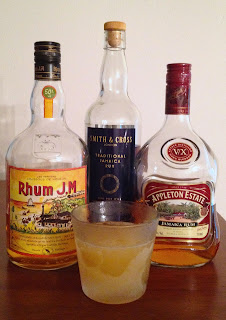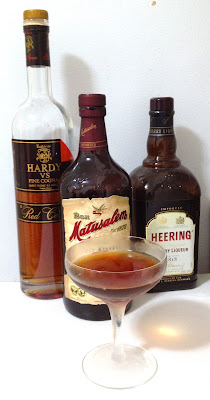Following up on two
previous reviews of Guyanese rums, I want to take a look at two Demeraras that share a lot of similarities, but still have very distinctive characters.
El Dorado 5 Year
Nose: lightly toasted oak, tropical fruits, prickles of spices, slightly buttery coffee, sugarcane, vanilla. After adding a little bit of water, molasses becomes more prominent
Taste: sweetly fruity up front, with passionfruit and mango coming out, mid palate has light molasses flavors, mild oak, mocha, and a veneer of vanilla riding over everything
Finish: bittersweet molasses, vanilla, a bit of oak and fruit - orange, primarily, with some more mango and passionfruit
El Dorado 5 Year, like all El Dorado rums, is produced by Demerara Distillers Limited from a number of their
vast collection of stills. ED5 is made purely from column still rums, though it does contain some rum from DDL's unique wooden Coffey still. While column stills sometimes get a bad rep, I think it was the right choice for this rum. ED5 offers a very balanced profile, somewhere between the lighter, fruitier spirit that one tends to find in white rums and the heavier, more molasses-driven aged rums. My hat goes off to the distillers and blenders of DDL as they have produced what I think is one of the best values in rum and possibly in the entire spirits world. ED5 usually runs between $15 and $20, which is better than a lot of other less flavorful rums. And as per
Captain Jimbo's analysis, I think that it even competes well against its elder
12- and 15-year old siblings. The older rums are much more focused on the deep, rich flavors of molasses, chocolate and oak, whereas the 5-year old contains those elements but leavens them with bright, tropical fruits. If you're looking to buy one rum for your home bar, El Dorado 5 Year easily tops the list. While heavier than a white rum, it's light enough to substitute into recipes calling for something unaged without muddying things too much, while at the same time it has enough heft to fit into recipes calling for an aged or dark rum. Truly, a magnificent example of how good rum can be at a price point that puts many other spirits to shame.
Even in a daiquiri, ED5 is still very fruit-forward. The tropical fruits that I found in the neat spirit team up very effectively with the lime to give it a strong tiki feel. There's still an undercurrent of molasses, but it's subservient to the fruit. The vanilla also comes out to give the drink a pleasant smoothness. Lastly, there's just a little bit of lingering bitterness at the end that detracts slightly from the experience, but it's subtle and may just be the result of using insufficiently fresh limes in my drink.
Air Mail
1.5 oz rum
0.75 oz lime juice
0.75 oz honey syrup
Combine all ingredients, shake with ice and strain into a glass. Top with sparkling wine.
The nose is dominated by the dry, slightly yeasty elements of sparkling wine, with fruit from the rum and lime as well as sweet notes of honey emerging. The sip is relatively crisp, with the snap of sparkling wine and lime, leavened by the smooth rum and honey.
Everything blends together beautifully in this daiquiri highball. The drink comes from
Esquire's 1949 Handbook for Hosts. While further provenance can't be established, Dr. Cocktail suggests that it's simply a nod to what used to be the fastest way to get information from one place to another. And this drink will certainly send you somewhere else in a hurry. The sparkling wine elevates it nicely and makes for a wickedly good summer drink. While the taste is light, it's deceptively potent. The fruitiness of ED5 fits well, but it could easily be swapped out for other rums. Rhum agricole would make it snappier, emphasizing the drier elements, whereas a big vanilla bomb like an aged Ron Matusalem would make it much softer. But no matter how you make it, this is a seriously tasty drink.
Lemon Hart 80 Proof
Nose: blackberries, curry spices - primarily turmeric, toasted oak, underlying hint of molasses, slightly sweet
Taste: relatively dry, some light blackstrap molasses mashed up with toasted oak
Finish: continues the dry flavors of oak and molasses, orange peel
Lemon Hart 80-proof is the lesser sibling of the brand's comparatively well-known and fêted 151-proof rum. While the latter has
returned to the U.S., fresh with new, classier packaging, it appears that the 80-proof version will not be coming to our shores. However it has found a new lease of life
on the Continent. Personally, I think the current owners would be best served by bringing in a 90-100 proof expression. I had a conversation with (I think) Steve Bennett of
Uncommon Caribbean about this and we agreed than a version in the mold of Mt. Gay's recently released 100-proof
Eclipse Black Rum would be an excellent fit for the current market. Basically, the way I feel is that if they're going to bring in something besides the current 151-proof, they need a way to differentiate the product from El Dorado 5 Year. As Lemon Hart is generally thought of as the brasher Demerara, a higher bottling proof would be fitting with the image, but it would be cocktail-friendly without having the connotations of a 151-proof rum.
For being a relatively brash, young rum, Lemon Hart 80 actually takes a bit of a back seat in a standard daiquiri. The nose is dominated by sweet lime, with a slightly rummy background. However the taste is much more interesting, with strong blackberry notes and a hint of banana emerging from the rum. It doesn't have the punch of its heftier sibling, but actually makes an extremely refined and pleasant daiquiri. While I'd still give the nod to ED5 over LH80, I can see why the latter has something of minor cult following.
Koni-Tini
1.5 oz light rum
0.5 oz Demerara rum
0.75 oz ginger liqueur
0.75 oz
falernum
0.75 oz lime juice
Combine all ingredients, shake with ice, and strain into a chilled cocktail glass. Garnish with a lime twist.
The nose presents some sharp notes of ginger with clove and allspice from the falernum, backed up by the Lemon Hart rum. The sip leads off with less sweetness than I would have expected given the ratio of liqueurs to lime. The mid-palate contains rich rum flavors from the Demerara and falernum, which then leads into sharper notes of ginger and lime, finishing with just a bit of residual heat.
This variation on the basic daiquiri comes from Jeff "Beach Bum" Berry via Fred of
Cocktail Virigin Slut. The drink comes together with excellent balance - the tangy ginger from the liqueur and falernum build a counterpoint to the smoother flavors of the rums. Though Lemon Hart rum is only a small constituent of this drink, I feel like it's still a good showcase for the rum's flavors. The Ron Matusalem Platino I used for the light rum is light indeed and presents a fairly blank canvas for the other elements. I'll admit to cheating a bit because Blair's Dark Falernum includes Lemon Hart 151, which helps to keep the Demerara rum present.
 As I've mentioned before, the Mai Tai is the classic tiki drink. It's a perfect example of how reshaping the basic rum sour recipe with multiple rums, liqueurs, and syrups can create drinks of unimaginable deliciousness. Even better, it's perfectly amenable to use with other base spirits.
As I've mentioned before, the Mai Tai is the classic tiki drink. It's a perfect example of how reshaping the basic rum sour recipe with multiple rums, liqueurs, and syrups can create drinks of unimaginable deliciousness. Even better, it's perfectly amenable to use with other base spirits.










